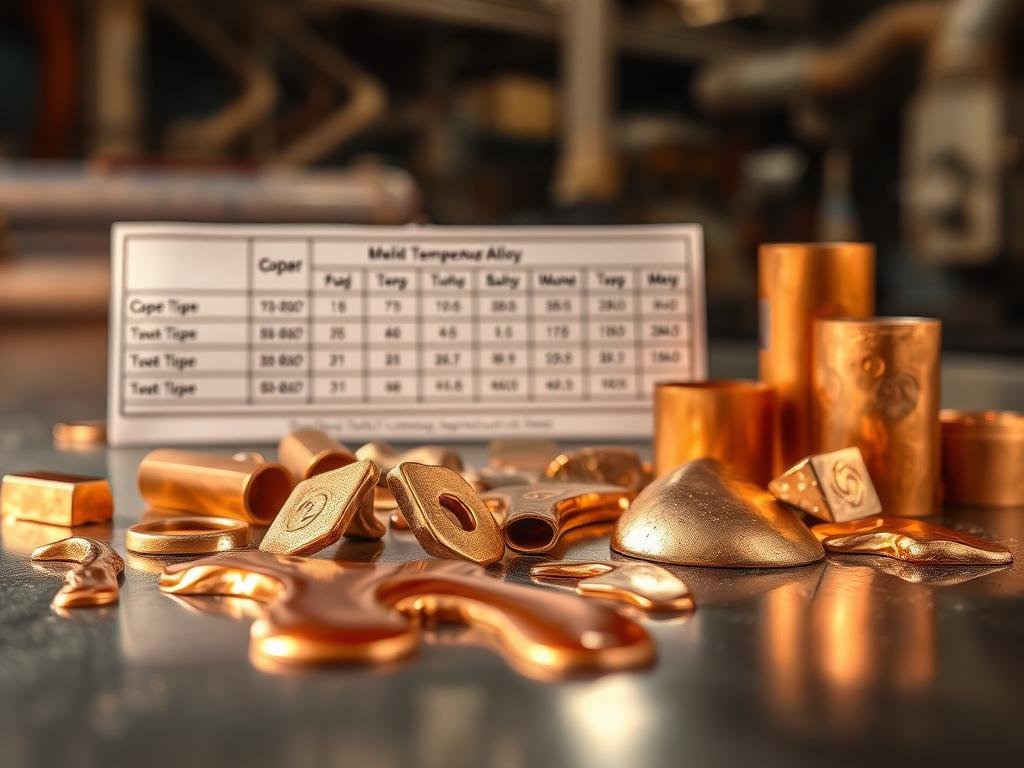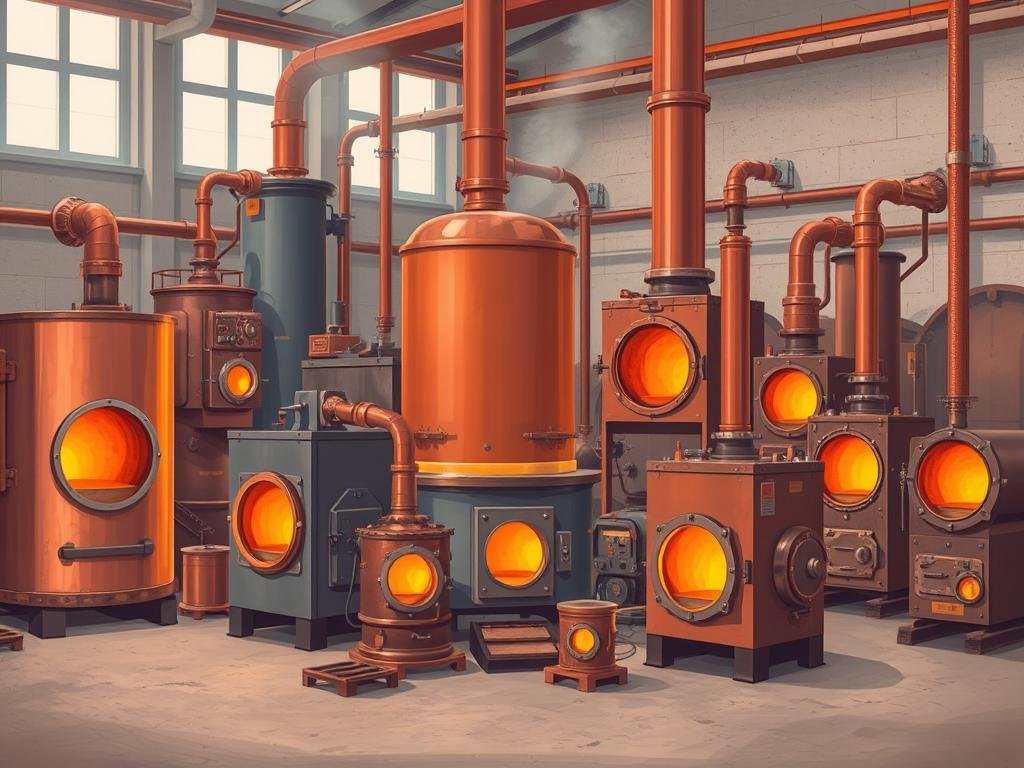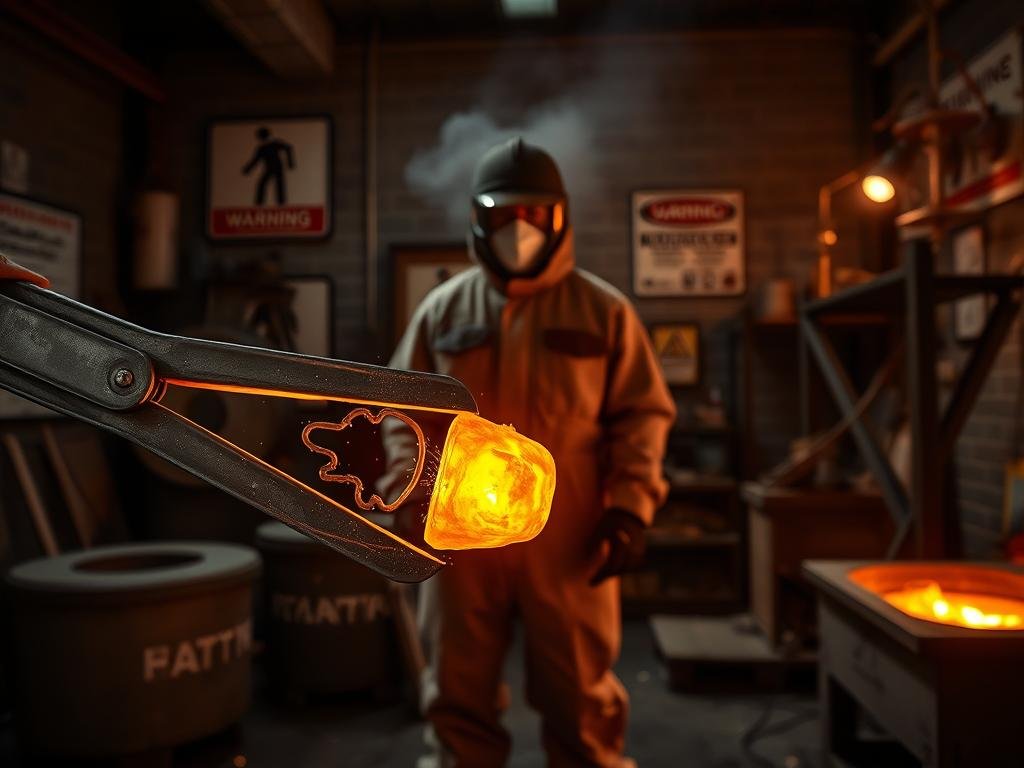Copper, a highly versatile metal, has a Schmelzpunkt of 1084°C (1983°F), making it a crucial material in various industries, including electrical wiring, plumbing, and metal fabrication.
The significance of copper’s Temperatur resistance is evident in its widespread use, from industrial applications to artistic endeavors. Understanding the properties that determine its melting behavior is essential for professionals working with this metal.
This comprehensive guide will explore the melting behavior of copper, comparing it to other common metals, and examining the factors that affect its melting temperature, such as purity levels and environmental conditions.
The Science Behind Copper’s Melting Point
Verstehen des Schmelzpunkt von Kupfer ist wesentlich für verschiedene industrielle Prozesse. Der Schmelzpunkt von Kupfer, der bei 1.085°C (oder 1.984°F) liegt, ist eine grundlegende Eigenschaft, die seine Anwendungen in der elektrischen Verkabelung, Kunst und anderen Bereichen bestimmt.
What Defines the Melting Point of Pure Copper
The melting point of pure copper is determined by the strength of the metallic bonds between its atoms in the crystalline structure. At 1,084°C (1,983°F), these bonds begin to break down as thermal energy overcomes the forces holding the atoms in place. Some key factors include:
- The face-centered cubic (FCC) crystal structure of copper, which affects how heat energy is distributed.
- The consistent and predictable melting point of pure copper, making it a reliable reference in metallurgy.
Molecular Structure and Heat Resistance
Copper’s molecular structure contributes to its heat resistance below the melting point, making it valuable for applications requiring thermal stability. The transition from solid to liquid occurs when copper atoms gain enough energy to overcome their lattice energy.
Understanding the behavior of copper atoms at its melting point helps engineers optimize processes involving heating this metal. This knowledge is crucial for manufacturing and material science applications.
Understanding Copper Melting Point in Different Measurement Systems
Copper’s melting point is a critical factor in various industrial applications, and understanding its value in different measurement systems is essential. Copper melts at 1,085°C, a temperature that is crucial for various technologies and applications.
Copper Melting Point in Celsius and Fahrenheit
The melting point of copper is precisely 1,084°C in the Celsius scale, which is the standard measurement system used worldwide. In Fahrenheit, copper melts at 1,983°F, a conversion relevant for industries in the United States. The Kelvin scale, used in scientific research, places copper’s melting point at 1,357.77K.
| Measurement System | Copper Melting Point |
|---|---|
| Celsius | 1,085°C |
| Fahrenheit | 1,984°F |
| Kelvin | 1,357.77K |
How Temperature Scales Affect Industrial Applications
Understanding these temperature conversions is crucial for international manufacturing operations. Industrial applications must account for these temperature scales to ensure consistent results. Temperature control systems must be precisely calibrated to the appropriate scale.
Factors That Influence Copper’s Melting Temperature
Several key factors can alter the melting temperature of copper, making it crucial for precise control in manufacturing processes. The melting point of copper is a critical property that determines its suitability for various applications.
Purity Levels and Their Impact
The purity level of copper significantly affects its melting temperature. For instance, 99.99% pure copper has a predictable melting point of exactly 1084°C. Impurities can either raise or lower the melting point depending on their nature.
Environmental Conditions Affecting Melting Point
Environmental conditions such as atmospheric pressure play a crucial role in determining copper’s actual melting point in practical applications. The presence of oxidizing or reducing atmospheres can alter the surface properties of copper, potentially affecting how heat is transferred to the metal.
Pressure Considerations in Melting Processes
Under increased pressure, copper’s melting point rises as atoms are forced closer together, requiring more thermal energy to break their bonds. This factor is critical in industrial melting processes where pressure can significantly impact the melting temperature.
| Faktor | Auswirkung auf den Schmelzpunkt | Industrielle Implikation |
|---|---|---|
| Reinheitsgrad | High purity (99.99%) results in a precise melting point of 1084°C | Ensures consistent results in precision applications like electronics manufacturing |
| Atmospheric Pressure | Increasing pressure raises the melting point | Requires careful control in industrial melting processes |
| Impurities | Can either increase or decrease the melting point | Necessitates careful selection of copper purity for specific applications |
Copper Alloys and Their Varying Melting Points
The melting points of copper alloys vary significantly based on their specific alloying elements. This variation is crucial for different industrial applications, where the melting point can affect the manufacturing process and the final product’s properties.
Brass: Composition and Melting Characteristics
Brass, an alloy of copper and zinc, typically has a lower melting point than pure copper, ranging from 900°C to 940°C. The exact melting point depends on the zinc content, making it suitable for various applications where a lower melting temperature is beneficial.

Bronze: Historical Significance and Thermal Properties
Bronze, historically one of the first engineered alloys, generally melts between 950°C and 1050°C. The tin content in bronze is the primary determinant of its specific melting point, allowing for tailored thermal properties for different uses.
Modern Copper Alloys in Industrial Applications
Modern industrial copper alloys are engineered with precise melting characteristics to suit specific manufacturing processes. For instance, beryllium copper has a melting range of approximately 870°C to 980°C, making it ideal for precision casting. Cupronickel alloys, used in marine applications, melt between 1170°C and 1240°C, demonstrating how nickel content can raise the melting point.
Understanding the relationship between alloy composition and melting point enables metallurgists to develop custom alloys for specific industrial requirements, making copper alloys invaluable in various industries.
Comparing Copper’s Melting Point to Other Common Metals
Understanding the melting points of various metals, including copper, is crucial for selecting the right material for specific tasks. Copper’s melting point of 1,085°C (1,984°F) positions it in the middle range among common industrial metals.
Copper vs. Aluminum: Melting Point Differences
Copper has a significantly higher melting point than aluminum, which melts at 660°C (1,221°F). This difference makes copper more suitable for high-temperature applications, while aluminum is easier to cast due to its lower melting point.
Copper vs. Iron and Steel: Temperature Thresholds
In contrast, iron has a substantially higher melting point at 1,538°C (2,800°F), and steel’s melting point varies between 1,370°C and 1,530°C, depending on its carbon content and alloying elements. Copper’s melting point is lower than iron and steel, but its higher melting point compared to solder materials ensures circuit boards remain intact during soldering operations.
Precious Metals Comparison: Gold, Silver, and Platinum
Among precious metals, gold melts at 1,064°C (1,947°F), slightly lower than copper, while silver has an even lower melting point at 961°C (1,764°F). Platinum, with its exceptionally high melting point of 1,768°C (3,214°F), is valuable for applications requiring extreme temperature resistance.
These comparisons highlight the importance of understanding melting points for manufacturing processes and material selection.
Industrial Applications Utilizing Copper’s Melting Properties

Industrial applications of copper are diverse, leveraging its melting properties for manufacturing and thermal stability. Copper’s high melting point ensures durability and reliability in electrical systems, making it perfect for wiring in electronics due to its excellent conductivity.
Electrical Wiring and Components Manufacturing
Copper’s high melting point is crucial for electrical wiring and component manufacturing, as it ensures that conductors remain solid even under high current loads that generate significant heat. The process of drawing copper wire involves heating the metal to near its melting point to increase malleability without losing structural integrity.
Plumbing Systems and Heat Exchangers
In plumbing systems, copper is used for pipes because it can handle hot water effectively. Copper pipes can be joined through soldering or brazing at temperatures well below copper’s melting point, creating strong, leak-proof connections. Heat exchangers utilize copper’s excellent thermal conductivity combined with its high melting point, allowing them to transfer heat efficiently while maintaining structural integrity.
Electronics and Circuit Board Production
Electronics manufacturing depends on copper’s precise melting behavior for creating circuit boards, where copper traces must withstand soldering temperatures without degrading. The predictable behavior of copper at high temperatures makes it invaluable in industries where thermal management is critical.
Copper in Art: Melting and Casting Techniques

For millennia, copper has been a favorite among artists, who have continually refined their techniques for melting and casting it into intricate works of art. The process involves heating copper to its Schmelzpunkt of 1084°C, transforming it into a luminous liquid with a greenish cast.
Historical Copper Casting Methods
Historically, copper casting methods employed charcoal-fired furnaces to achieve the necessary high temperatures. The lost-wax casting technique, developed around 4500 BCE, remains fundamental for creating intricate copper sculptures. Artisans developed specialized crucibles and tools to handle the molten material, showcasing their skill and craftsmanship.
Modern Artistic Applications of Molten Copper
Modern artists continue to explore copper’s unique properties, combining traditional casting methods with modern temperature-control technology. The pour temperature is typically maintained between 1150-1200°C to ensure proper flow into complex molds. Patination techniques applied to cast copper create distinctive finishes, with the metal’s thermal properties influencing these chemical reactions.
Methods and Equipment for Melting Copper

Copper melting involves various methods and equipment designed for different applications. The choice of equipment depends on the scale of operation, from small-scale art foundries to industrial processes.
Furnaces and Crucibles for Copper Processing
Industrial furnaces for copper processing include induction furnaces, which use electromagnetic fields to generate heat directly within the metal, offering precise control and energy efficiency. Electric resistance furnaces are also commonly used, particularly for larger batches.
Crucibles for containing molten copper are typically made from materials with much higher melting points, such as graphite or silicon carbide, ensuring they maintain structural integrity during the melting process.
Temperature Control Systems and Monitoring
Temperature control systems are critical in copper melting operations. Thermocouples and pyrometers provide real-time monitoring to maintain optimal conditions and prevent overheating, ensuring the quality of the molten copper.
Small-Scale vs. Industrial Melting Processes
Small-scale operations, such as those in art foundries or jewelry making, often use propane or natural gas furnaces with refractory linings. Industrial-scale copper melting typically employs continuous process furnaces with sophisticated automation systems controlling temperature profiles throughout the process.
Energy efficiency is a key consideration in copper melting equipment design, with modern systems incorporating heat recovery mechanisms to capture and reuse thermal energy. Safety features include emergency shutdown systems, thermal insulation, and specialized ventilation to manage fumes and prevent workplace hazards.
Safety Considerations When Working with Molten Copper
Safety is paramount when working with molten copper, given its high melting point and potential hazards. Working with molten copper at temperatures exceeding 1084°C presents significant safety hazards that require strict protocols and appropriate protective equipment.
Protective Equipment and Workspace Requirements
Personal protective equipment (PPE) for handling molten copper includes heat-resistant clothing, face shields with infrared protection, insulated gloves, and footwear designed to protect against splashes of molten metal. Workspace requirements include proper ventilation systems to remove potentially harmful fumes, fire-resistant flooring and walls, and clear access to emergency equipment.
The table below summarizes the essential PPE and workspace requirements for safely handling molten copper:
| PPE/Workspace Requirement | Beschreibung |
|---|---|
| Heat-resistant clothing | Protects against heat and splashes |
| Gesichtsschutzmasken mit Infrarotschutz | Guards against intense heat and molten metal |
| Angemessene Belüftungssysteme | Removes harmful fumes and particles |
Handling and Emergency Procedures
Safe handling procedures for molten copper involve using appropriate tools such as ceramic-tipped tongs, pre-heated ladles, and secure pouring mechanisms to prevent splashing or spills. Emergency procedures must be established before beginning any copper melting operation, including access to appropriate fire extinguishing equipment and first aid supplies.

Temperature monitoring is critical for safety, as overheated copper can become more volatile and potentially cause equipment failure or dangerous splashing. Training requirements for personnel working with molten copper should include recognition of hazards, proper equipment use, and emergency response.
Welding Copper: Techniques Based on Melting Properties

Effective copper welding demands a thorough grasp of its melting properties and heat management. Copper’s high thermal conductivity and melting point require specialized welding techniques.
TIG, MIG, and Stick Welding Applications
TIG (Tungsten Inert Gas) welding is often preferred for copper due to its precise heat control. MIG (Metal Inert Gas) welding is effective for thicker copper sections, utilizing copper alloy filler wires. Stick welding, though less common, can be used with specialized electrodes.
Brazing and Soldering: Lower Temperature Joining Methods
Brazing involves using a filler metal with a lower melting point than copper, operating between 1112°F and 1652°F. Soldering is a lower-temperature option, typically below 350°C, useful for electrical connections where maintaining copper’s conductivity is crucial.
The strength of welded copper joints depends on proper temperature control, as overheating can lead to porosity and underheating can result in lack of fusion. Copper-nickel alloys are often easier to weld due to their reduced thermal conductivity.
Energy Requirements and Efficiency in Copper Melting
Copper’s high melting point necessitates a substantial energy input for industrial melting processes. The melting point of copper at 1084°C requires significant energy, with typical consumption ranging from 400 to 800 kWh per ton of copper processed.
Calculating Heat Input for Melting Operations
To melt copper efficiently, understanding its specific heat capacity (0.385 J/g·K) and latent heat of fusion (205 J/g) is crucial. These properties determine the total energy required to transform solid copper into its liquid state.
- Specific heat capacity: 0.385 J/g·K
- Latent heat of fusion: 205 J/g
Sustainable Approaches to Copper Processing
Modern copper melting facilities are adopting sustainable practices to reduce energy consumption. Induction melting technology has improved efficiency, achieving up to 70% energy efficiency. Other sustainable approaches include using recycled copper, which requires approximately 85% less energy to process than virgin material.
Fazit
The melting point of copper, at 1084°C (1983°F), is a fundamental property that has shaped its role throughout history and continues to define its applications in modern technology. Copper’s high thermal conductivity and durability make it invaluable in electrical, plumbing, and industrial applications.
Factors such as purity levels and environmental conditions influence its melting temperature, enabling precise control in manufacturing. As technology advances, new techniques for working with copper near its melting point emerge, expanding its possibilities.
